A number of artists have attempted to render the striking visual experiences that occur after ingesting ayahuasca or DMT. In the Upper Amazon, there are both indigenous artists, whose traditional work consists largely of abstract patterns, such as those found on the now well-known pottery, clothing, and other household goods of the Shipibo; and visionary artists, mostly mestizo, whose work is characterized by detailed representations of spirits, trees, animals, objects, and participants in ayahuasca healing ceremonies. These latter works fall almost paradigmatically within what has now come to be called outsider art, sometimes naïve art, and sometimes visionary art — direct, intense, content-laden, narrative, enormously detailed, personal, idiosyncratic, two-dimensional, and brightly colored. While indigenous artists work for the most part in anonymity, their work stigmatized as craft rather than art, the work of mestizo visionary artists has become much better known, largely through the publication, fully annotated and sumptuously reproduced, of the visionary paintings of former shaman Pablo César Amaringo.
Outside the Amazon, artists not born into or raised in indigenous or mestizo ayahuasca-using cultures, including such well-known visionary artists as Alex Grey, Robert Venosa, and Martina Hoffmann, have also rendered visual experiences attributed to the ingestion of ayahuasca or DMT. For want of a better term, I will call this body of work DMT art.
There are some remarkable convergences between DMT art and the abstract representations of the ayahuasca experience in indigenous Amazonian art. The indigenous work on the left, below, by Cashinahua artist Arlindo Daureano Estevão, represents the different worlds of the ayahuasca vision as houses with doors to be entered and paths linking the different contained spaces. This type of design is called nawan kene pua, or stranger’s design, since it is a map that keeps one from getting lost in the ayahuasca world. This abstract representation is strikingly reflected in the work on the right, below, entitled DMT, by photographer Peter Kosinski. It is difficult to say whether such convergences are due to acquaintance with indigenous art or to similarities in the visionary experience.
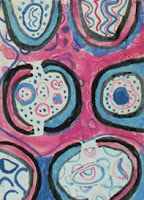 |
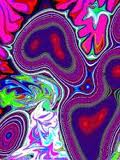 |
| Arlindo Daureano Estevão, Nawan Kene Pua | Peter Kosinski, DMT |
 |
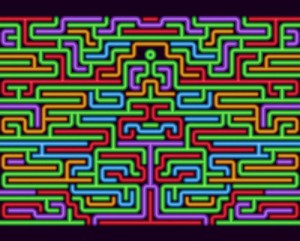 |
| Anonymous, Shipibo Woven Cloth | Vibrata Chromodoris, Emergence |
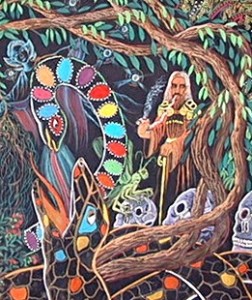 |
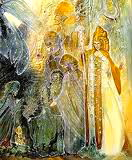 |
| Pablo Amaringo, Ayahuasca and Chacruna (Detail) | Robert Venosa, Ayahuasca Dream (Detail) |
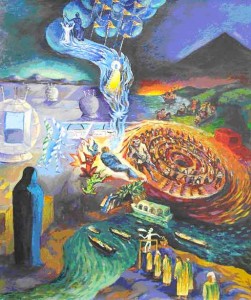 |
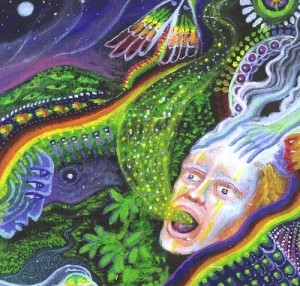 |
| Cyril Lanier, Ayahuasca Vision of the Blue Perfume | Michael Jacobs, Ayahuasca Dream |
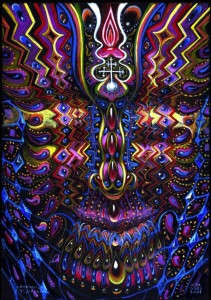 |
 |
| Alex Grey, Ayahuasca Visitation | Roger Essig, DMT Entity |
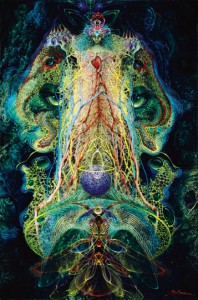 |
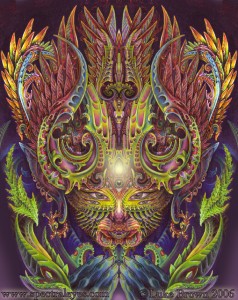 |
| Martina Hoffmann, La Chacruna | Luke Brown, Pineal Feline |
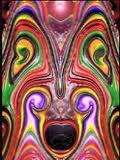 |
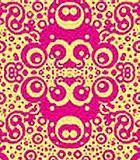 |
| Dennis Konstantin, DMT Entity | Nisvan, Ayahuasca Vision (Detail) |
Another recurring motif we can call the wingspread. This is a pattern very similar to the wings of a moth or dragonfly. Below, for example, is a more or less typical moth — actually, the tobacco hornworm moth (Maduca sexta):
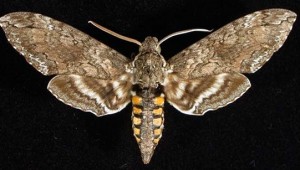 |
| Wingspread Moth |
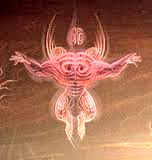 |
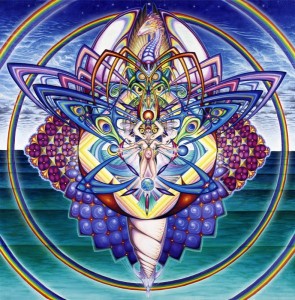 |
| Dennis Konstantin Last night I was Astro Dynamic (Detail) | Carey Thompson, Diosa Madre Tierra |
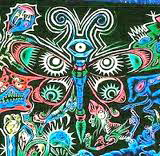 |
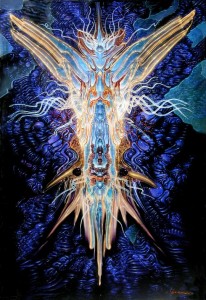 |
| Danny Gomez, DMT (Detail) | Robert Venosa, Yage Guide |
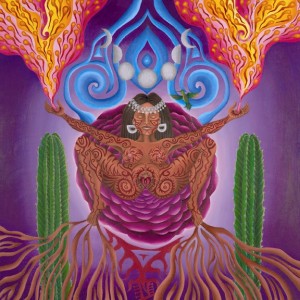 |
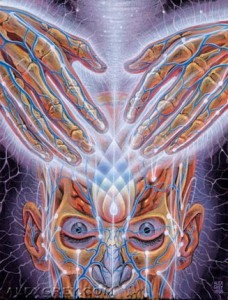 |
| Mariela de la Paz, Ayahuaska at the Gates of San Pedro | Alex Grey, Light Weaver |
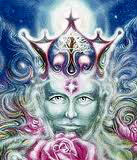 |
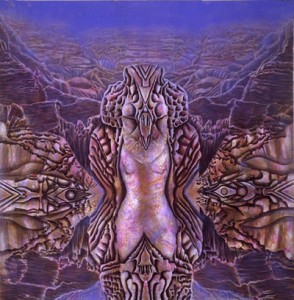 |
| Alejandre Segrégio, Presente Divino (Detail) | Olga Spiegel, Rendezvous |

- Previous Post: The Jungle Cookbook
- Next Post: The War on Coca Leaves
- More Articles Related to: Ayahuasca, Books and Art



Hi, I’ve just discovered your blog. I’m just beginning to explore it, but there is a wealth of fascinating information. Anyway, I am an artist as well, though mostly influenced by Salvia Divinoru. I was wondering what you would think of my art. Please check it out on http://www.SpreadLove.ca
Thanks a lot!
Andrew
Hi, Great post Steve on this truly amazing subject.
It’s great to finally see Alex Grey’s ‘Ayahuasca Visitation’ directly beside mine. I sent Alex an email just after I completed my version and he mentioned it reminded him of an experience he had. We both did our artworks roughly the same time in 2000/2001, and I saw his version months later in his book, ‘Transfigurations’. Take a look at the purple third eye for a pretty spot on synchronicity. His version is better of course, for the fact that it’s hand drawn/painted, while my version was made entirely in photoshop.
The Experience I had was quite a powerful, wrathful encounter, where I had the realisation that I had to fight it off with my will and intention lest it briefly take over my essence entirely on some level. It was issuing some form of challenge and definitely had the feeling of a guardian. Perhaps if I gave into it, by giving up my lucidity in the moment, I may have progressed into the experience far deeper, I may never know.
I have since enquired to Alex his thoughts via email during a radio interview, his response and my animated version of the experience can be found here…
http://www.youtube.com/watch?v=aFjEMe7KJVU
Peace,
Roger Anthony Essig (not robert!)
Thank you so much for your comment. I apologize for getting your name wrong on this blog post. I knew it was Roger, but somehow I just typed it in wrong — alas, another of the increasingly common disconnections between my fingers and my brain.
Your interview with Alex Grey is also fascinating. Thank you for the link. I really appreciate your stopping by. Come back any time.
Steve
Great article! The side-by-side images provide so much additional synergy to the visual mapping pattern-detecting function (at least for my brain…) I just got back from a Prajnaparamita empowerment ceremony (last night) so perhaps my mind is still focused on the question of clear light vs. illusion. In Bardo, we see what we expect (or have accepted via cultural programming). Yet some Tibetan masters suggest that not everything in Bardo is purely subjective. "External" entities are sometimes not just (only) our projected dreams or nightmares. With DMT is it any different? Most folks experience an overwhelming sense of one or more entities – natural but alien. Perhaps not friendly or malicious, seemingly knowledgeable but beyond emotion. This aspect of the experience is what takes it beyond simple mental pattern projection upon "quantum perceptual noise"… It's the utter strangeness, the self-contained self-defining self-evolving properties of the experience that makes the entities accepted as real. BTW: the Alex Grey "LIght Weaver" piece with the "hidden" moth wing pattern structure is quite something to contemplate!
cheers,
-mg-
sacred & visionary art blog: http://www.image-maya.org
Thank you for your very kind comment. I really did enjoy writing this post.
And thank you for the link to your truly amazing blog. People should also know about your Shaman Dreaming website, your art work, your landscape design, your graphic design. You do remarkable luminescent work.
Thank you for dropping by and leaving a comment. Please feel free to wander around and enjoy yourself.
Steve,
awesome blog i very much enjoyed reading it. i myself have just found out about DMT and art inspired by it. prior to learning anything about DMT i was already a very big fan of alex grey because i came across a book of his. from the moment iopend that book i was cultivated by his uniqueness and found other artists that have ‘similar’ styles. i myself have never tried DMT though i must say i’m quite eager to (im just having trouble finding any and cant get the supplies at the moment:[ ), ive only done LSD. DMT seems like an amazing enlightining experience visualy mentaly and spiritualy i look forward to the experience … whenevr that my be hahaha
sincerly
Natavian
Very interesting blog post Steve-
Regarding “the face” – I would encourage you to explore some ancient art from china, from the Shang & Zhao dynasties. There is a repeating motif of a face called a Tao-tie – which is largely composed of what appears to be coiling/undulating enegry, mostly molded in bronze. Although not often referenced today, there are ancient references to ritual mushroom use, which may explain some of the similarities.
I am curious how these motifs / messages / memes / hallucinations can be reduced to chemicals and transmitted with such effectiveness by plants. Similarly, I often meditate on the relationship with plants and animals that our proto-human and Paleolithic ancestors had. I believe there were deeper levels of communication at play than we tend to believe today…
I respect you more each day Steve :)
I too “am curious how these motifs / messages / memes / hallucinations can be reduced to chemicals and transmitted with such effectiveness by plants. Similarly, I often meditate on the relationship with plants and animals that our proto-human and Paleolithic ancestors had. I believe there were deeper levels of communication at play than we tend to believe today…”
Fascinating article…I would love to see more information on this topic, especially the comparisons of the work of different artists who have had a similar experience or vision.
Beautiful. Breathtaking. I have some personal DMT artwork. Would love to get them seen by ppl. ;)
Some beautiful artwork here. If any of you artists out there want to share your dmt visions I would be thrilled to host them at site pay-amb.blogspot.com
Here is a post about dmt art I did recently :
http://psy-amb.blogspot.jp/2013/11/dmt-art-40-visionary-paintings-inspired.html
I’d love to hear from anyone who creates art directly as a result of their dmt experience.
Cheers
Psyamb
My husband is Wahid Azal, a prominent voice on visionary plant culture in Islam.
http://realitysandwich.com/76773/fatimiya_sufi_ayahuasca/
Our experience of “visions” is perhaps a little different although relating in some elements such as fractal visions. The animals we see are our ancestral animals (such as the Simurgh) but we already have a rich visionary culture within and outside “induced states”. This is due to our tradition (Sufism/Shia Islam) that inspires and encourages a rich imagination to commune with God and the divine with and without the help of plant-aids. Just take a look at classical Iranian architecture to see what I mean,
http://thespicejars.files.wordpress.com/2013/05/stunning-architecture.jpg
I claim that spiritual visionary journeys are possible with and without the aid of plants with such assurance as I personally can neither take chemicals nor enjoy visionary plants due to risk of seratonine syndrome, but I have experiened fractal visions and similar in states of high focus during prayers and long zikr sessions. I have experienced “visions” of “la madre” and similar as a collective as well as individual event but my interpretations are less DMT art focused, to avoid the cliche and shift to other aspects of the journey. When spiritual images come to a mind all happens in a time-lapse, ie in a single instance do we travel landscapes, the universe and hidden subtle realms. Again, I communicate with “la madre” and plant spirits without having so far ever been able to enjoy any Aya or similar. What I learned I learned through Sufism and Shi’ism.
http://sweetmysticrecipes.wordpress.com/2014/08/01/%D8%B0%D9%88-%D8%A7%D9%84%D8%AC%D9%84%D8%A7%D9%84-%D9%88-%D8%A7%D9%84%D8%A5%D9%83%D8%B1%D8%A7%D9%85-dhu-al-jalal-wa-al-ikram-the-recital-of-life/
Thank you for your great work Steve Beyer.
Allah hafiz, Roya Azal
Check out some contemporary psychedelic art at arthousecontemporary.com
Let us know what you think! Enjoy
Check out the affordable gallery of original paintings at Ayahuasca-Art.com, we seek to:
1. Promote and support visionary artists from the Amazon basin who draw inspiration from ayahuasca, and
2. Provide original, affordable art to help people stay connected with the energies of the plant medicines